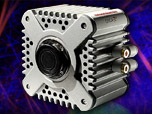Image Galleries
Featured Article
 Electron Multiplying Charge-Coupled Devices (EMCCDs)
Electron Multiplying Charge-Coupled Devices (EMCCDs)
By incorporating on-chip multiplication gain, the electron multiplying CCD achieves, in an all solid-state sensor, the single-photon detection sensitivity typical of intensified or electron-bombarded CCDs at much lower cost and without compromising the quantum efficiency and resolution characteristics of the conventional CCD structure.
Product Information
Interactive Java Tutorials
Analog to Digital Conversion
The output from a majority of present-day video sensors and cameras, such as charge-coupled devices (CCDs) and vidicon tubes, is still in the analog form. With analog signals, the first stage in digital image processing systems is an electronic digitizer, the analog-to-digital (A/D) converter, or ADC, utilized to convert the analog output of the camera or sensor to a sequence of integer numerical values.
The analog-to-digital converter changes the incoming analog video signal stream into a series of integers conceptually structured as in a video frame, as illustrated in the tutorial above. For example, the video frame may be divided into 640 equal-size boxes and vertically into 480 boxes (the number of effective video scan lines). Each horizontal video scan line is thus subdivided into 640 discrete units, each representing a time interval, or distance along the x-axis of the video image. Each box holds the integer number that specifies the amplitude of the video signal (image brightness) at that location. As a digital signal, a particular location is given by two integer numbers that denote its x and y coordinates, together with the integer that denotes the signal amplitude. Thus, a video frame is represented by an array of numbers that include the location of each box and the encoded value of the signal at that location. The analog voltage must be sampled frequently enough in time (i.e., space along the horizontal scan line) and amplitude (or brightness) to produce a faithful numerical reproduction of the signal.






